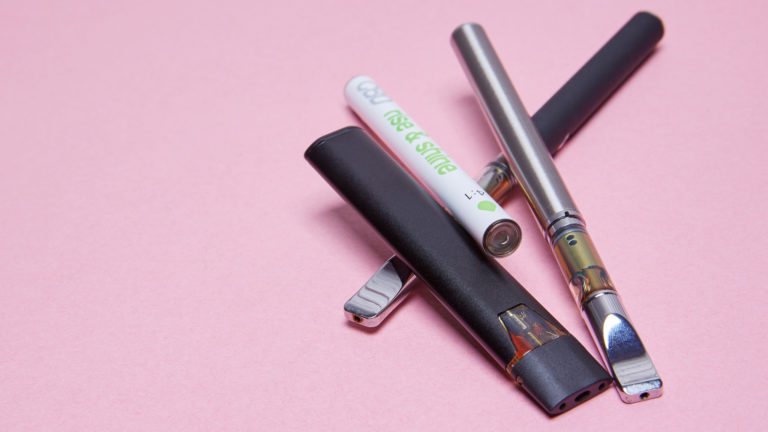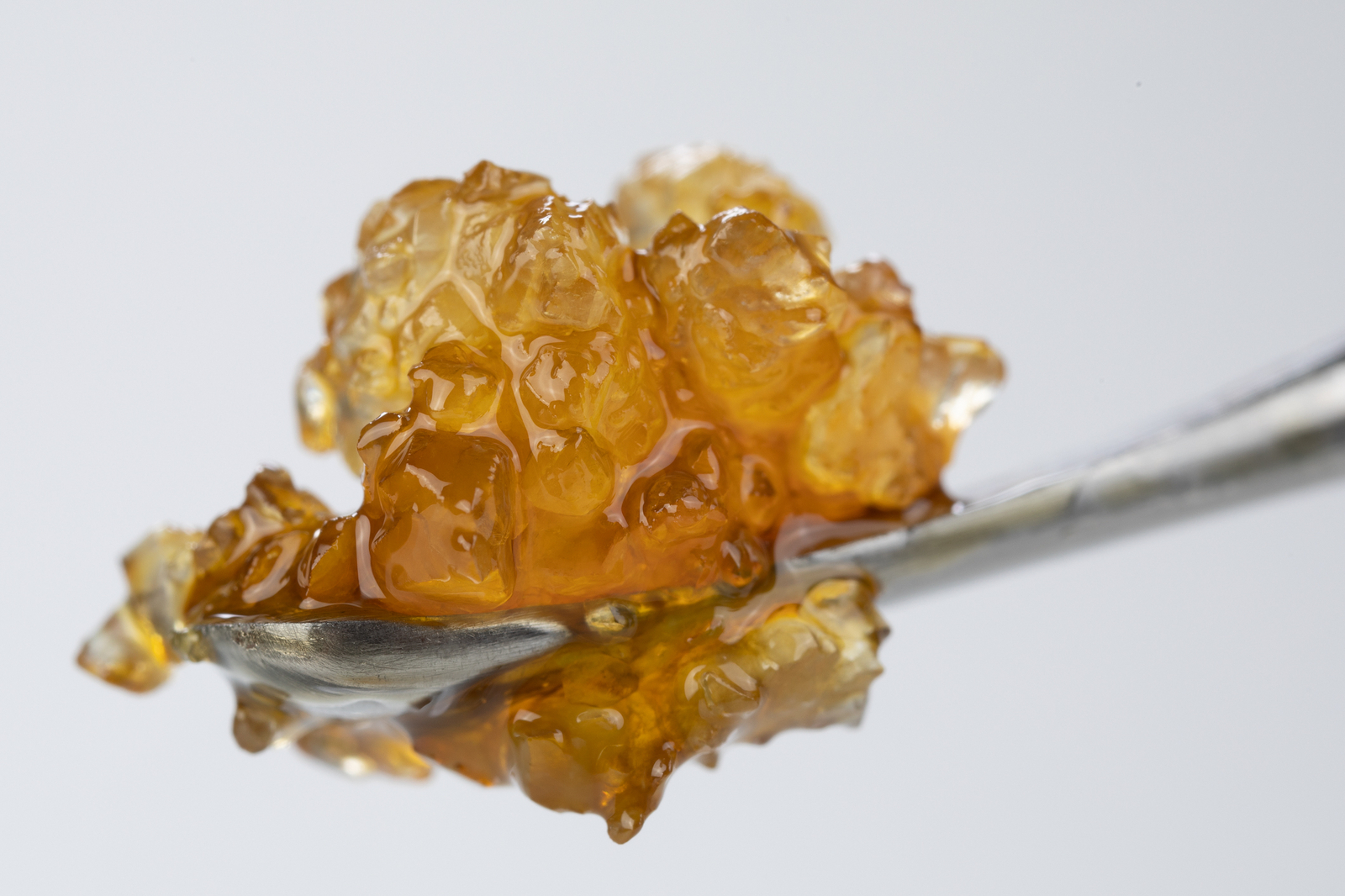Vaping is a popular way of consuming cannabidiol (CBD) for two obvious reasons: it offers a healthier option than smoking while still providing a quick onset of effects. If you just bought your first CBD vape or are looking to try vaping for the first time, this article will give you both the information and tools to help you figure out how much CBD to vape.
Find CBD vapes on the Weedmaps app
A word on vaping and bioavailability
Before getting into how much CBD you should vape, it's useful to understand why vaporization and the inhalation of CBD are generally beneficial and useful. One of the primary benefits of inhaling weed versus ingesting weed is that it offers a much higher bioavailability. This means that more of the CBD you consume will make its way into your bloodstream.
 Photo by: Gina Coleman/Weedmaps
Photo by: Gina Coleman/WeedmapsImage lightbox

According to Dr. Adie Rae, a neuroscientist at the Legacy Research Institute in Portland, Oregon, and a scientific adviser to Weedmaps, "Vaping CBD is a better choice than eating/swallowing it because the lungs are far more efficient at getting CBD into the bloodstream. The bioavailability of CBD is greater through the lungs than through the gut. Specifically, about half of the CBD you inhale makes it into the blood, but only 5% of the CBD you eat gets into your blood."
That's not to say that other ways of taking CBD, like a sublingual tincture or an edible, are any worse or better than vaping, just that each consumption method has its own advantages and disadvantages.
While vaping gets more CBD into your bloodstream with a quick onset, the effects don't last as long. On average, the effects of inhalation will last two to four hours, while the effects of an edible might last upwards of eight to twelve hours. Ultimately, each product and consumption method is another tool in your wellness toolbox, useful at different times and when different needs arise.
Bottom line:
- Vaping, and inhalation in general, offer a more efficient way of getting CBD into your bloodstream
- The onset of effects with inhalation is quick, but this delivery method won't provide the long-lasting effects you get from ingesting CBD oil, tinctures, or edibles
Finding the right dosage for you
OK, so exactly how much CBD should I vape? That depends. Finding the right dosage of CBD for you depends on a variety of factors, and each person's endocannabinoid system is unique. A person's weight, diet, metabolism, and other medications they might be taking will impact how much CBD they should vape, along with the specific reason they are taking CBD (sleep, pain, or a chronic illness for example). Because of this, there aren't standard dosing protocols for cannabinoids like CBD as there are for other prescription medications like ibuprofen or aspirin, for example.
Often, it will take some experimentation to find the right CBD dosage for you to vape, and it's important to consult with your physician before you begin a vaping regimen. Generally, when it comes to dosing cannabinoids, physicians recommend a gradual increase (or titration) upwards until you find the lowest effective dosage. You might have heard the adage “start low and go slow,” meaning you should start with a low dose and give your body several days to adjust before increasing the dose.
Consult the label and/or other package information for details on how much CBD is in the vape oil you purchased. You should see the total CBD contained in the cartridge, along with an approximation of how much CBD is in each inhalation.
“While it's almost impossible to know the precise amount that gets into your bloodstream, you can estimate how much is leaving the cartridge,” explains Dr. Rae. Depending on how detailed the product's packaging is, it might require a little math. “Divide the weight of CBD in the total package by the number of servings in that package (which may vary depending on the manufacturer). One common 'serving size' that manufacturers use is a 3-second pull.”
Take for example a half-gram cartridge that contains approximately 75 servings and has a total 250 mg of CBD inside the cartridge. Divide 250 mg by 75 servings and you get about 3.33 mg of CBD per 3-second pull.
So while the “serving size” may be less intuitive than it is with edibles or tinctures, a 3-second pull can approximate one dose with a vape pen. If it's your first time trying a CBD vape pen, take 1-3 pulls, wait 15 minutes, and see how you feel before vaping more.
Bottom line:
- The right dosage of CBD is unique to each person
- When figuring out what dose to take talk to your doctor, start low and go slow
- Consult the product package for information on total CBD content and serving sizes
- One “serving” of a vape pen is typically a three-second pull
Full-spectrum, broad-spectrum, or isolate?
CBD products are made with concentrated extractions that are taken from hemp or cannabis plants. These extracts can vary depending on what compounds are taken from the plant and how they are refined or changed after extraction.
Full-spectrum and broad-spectrum products are made with extracts that have retained most, if not all, the beneficial compounds from the source plants — we're talking cannabinoids, terpenes, and flavonoids to name a few. That said, broad-spectrum products have been further refined to remove all traces of THC.
Full-spectrum products may have been made using hemp or cannabis plants, and so their THC content can vary quite a lot. Be sure to consult labels and packaging to verify how much THC versus CBD is in the cartridge. Often the THC versus CBD content is expressed in ratios. Keep in mind that products that have a higher THC to CBD ratio will create more of the euphoric “high” feelings associated with THC, while products that have a higher CBD ratio will produce less or none at all depending on the ratio.
Isolates are extracts that have been highly refined to be as close to 100% pure CBD as possible, and they are often used to make vape oils. Sometimes terpenes are added back to isolates to create a particular scent, taste, or desired effect.
For the most part, full- and broad-spectrum oils are better supported both in scientific literature and anecdotally by folks who use them. “Look for a full-spectrum oil, not one that is CBD distillate,” said Dr. Rae. “Scientists believe that there are greater benefits (or fewer risks) with broad-spectrum products you miss out on when you're consuming CBD isolate.” There is mounting evidence to support that the active compounds in a whole-plant extract work synergistically to provide a more potent therapeutic effect than isolates.
Bottom line:
- Scientists believe that there are greater benefits to full- and broad-spectrum concentrates
- When you can, choose a full- or broad-spectrum oil over an isolate
Shopping for CBD vapes safely
Since the Center for Disease Control (CDC) identified a quickly growing population of patients with lung illness linked to the use of vape oils in 2019, consumers have become more concerned with finding safe and high-quality vape products. As the investigation into this new illness continues, possible causes include cutting agents like vitamin E acetate and other additives, flavorings, and poor-quality counterfeit products.
 Photo by: Gina Coleman/Weedmaps
Photo by: Gina Coleman/WeedmapsImage lightbox

The number one thing to look for when buying CBD vape pens? "Look for pure cannabis/hemp ingredients — no added ingredients whatsoever, just 100% hemp/cannabis oil. Some additives have been linked to lung injuries, and others (added flavors, even terpenes) have not been studied enough to know their safety," advised Dr. Rae.
The next thing to consider is where the plants used to make the concentrates came from and how they were grown. You should be able to examine an independent third party lab's certificate of analysis (or COA) for any product you're interested in buying. Dr. Rae stressed that it is “not just important but critical that the product is either certified USDA organic or is purchased from a licensed cannabis dispensary — or both. This will ensure that the source plant was not sprayed with pesticides. Pesticides are especially important to avoid when you're inhaling because your body does not get the benefit of first-pass metabolism.”
“When you eat something, the liver filters out all the toxins before things go into the bloodstream and this is called 'first-pass metabolism,'” explained Dr. Rae. “When you inhale something, there is no protective filter. Toxins and all go straight into the blood and get distributed throughout the body.”
Seek out vaporizers that have variable heat settings, since higher temperatures can create more unhealthy byproducts. Make sure that the heating element is made from ceramic, too. According to Dr. Rae, “both of these help to ensure that your oil vaporizes at the lowest temperature possible as studies have shown that the higher the temperature is, the greater number of toxic byproducts are produced."
New regulations, signed into law via The Appropriations Act in December 2020, will introduce restrictions on the vape industry at large, including CBD and hemp vapes. These regulations will impose significant restrictions on the mailing of all vape-related products, in addition to amending existing laws regarding selling vape products to minors. You can expect to see the effects of these new regulations in the coming months, as retailers work to comply with the new requirements.
As an alternative to vape oils, you could consider vaporizing cannabis or hemp flower with a flower-friendly vaporizing device as well.
Bottom line:
- Buy certified organic full-spectrum products
- Buy from licensed dispensaries or online retailers who can provide certificates of analysis (COAs) for the product
- Use a vape pen or other vaporizing device with variable heat settings and use the lowest settings
Taking CBD with other medications
You should always consult with your doctor before adding CBD to your daily regimen, and that is especially critical if you're taking any medications. A knowledgeable healthcare provider can tell you if any of the medications you are currently taking will interact with CBD.
“Like any other CBD product, be careful if you're taking any kind of prescription medication that has a 'grapefruit warning on the label,” advised Dr. Rae.
If any of your prescription medications come with a warning to avoid grapefruit on the label, chances are it will interact with CBD, and this interaction could be potentially dangerous. This is because the grapefruit warning signals that the medication is metabolized by a group called the cytochrome P450 enzymes. At high enough doses, CBD can temporarily deactivate these enzymes leading to increased levels of the drug in your bloodstream.
According to a 2019 report published in the Journal of Clinical Medicine, CBD might interact with a number of different drug classes, including immunosuppressants, chemotherapeutics, and antidepressants, so be sure to get the green light from your physician before adding CBD oil, vapes, or other products to the mix.
Bottom line
Vaping can provide an efficient way to consume CBD with a quick onset. Finding the right amount of CBD to vape will depend on your own physiology, and it might require some careful experimentation. Always consult with a doctor before starting a CBD vaping regimen and look for products derived from organic hemp plants and cannabis oil without any other additives. Purchase from licensed dispensaries or online retailers that can provide you with independent third-party lab testing results.
Major contributions from Dr. Adie Rae.



